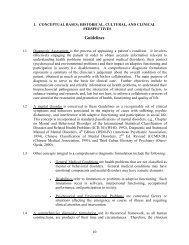ABSTRACTS - World Psychiatric Association
ABSTRACTS - World Psychiatric Association
ABSTRACTS - World Psychiatric Association
You also want an ePaper? Increase the reach of your titles
YUMPU automatically turns print PDFs into web optimized ePapers that Google loves.
sequencing of the pathway to care of patients experiencing a first<br />
episode of psychosis and the determinants of these pathways to better<br />
inform the provision of mental health services.<br />
RS12.3.<br />
PATHWAYS TO CARE AND DURATION<br />
OF UNTREATED PSYCHOSIS: THE IMPACT<br />
OF CULTURE AND ETHNICITY<br />
S.P. Singh<br />
Health Sciences Research Institute, University of Warwick,<br />
Coventry, UK<br />
Ethnic minority patients in the UK experience adverse pathways into<br />
care in early psychosis. This has been attributed to “institutional<br />
racism” in psychiatry, despite lack of evidence to substantiate this<br />
charge. Early intervention services aim to deliver effective intervention<br />
as close as possible to the emergence of psychosis, thereby reducing<br />
duration of untreated psychosis (DUP) and promoting early and<br />
enduring recovery. Early intervention services are therefore ideally<br />
placed to explore ethnic and cultural factors that contribute to such<br />
delays and identify service response to reduce or eliminate ethnic differences.<br />
Two literature reviews of structured measurement tools in<br />
early psychosis were conducted: one for measuring pathways to care<br />
and the other for measuring DUP. In 15 studies of pathways to care in<br />
early psychosis, six different measures have been used. While ethnic<br />
minority status is associated with adverse pathways in UK studies,<br />
most pathways measures do not include ethnic and cultural variables<br />
which determine help-seeking behaviours. The DUP literature shows<br />
a reported mean DUP ranging from 25 weeks to 166 weeks. The relationship<br />
between long DUP and poor outcome is confounded by an<br />
interaction between premorbid dysfunction, insidious onset, and poor<br />
clinical course. Cultural variation in explanatory models of illness<br />
may be a major determinant of help seeking and hence DUP, but this<br />
has received very little attention in published reports. While the conceptual<br />
and methodological problems in quantification of pathways<br />
to care and DUP have been well documented, the key role of ethnic<br />
and cultural variations in help seeking is as yet poorly understood.<br />
RS12.4.<br />
INTERVENTIONS TO REDUCE DELAY<br />
IN TREATMENT OF PSYCHOSIS: DO THEY WORK<br />
A. Malla<br />
Department of Psychiatry, McGill University, Montreal, Canada<br />
This paper reviews different strategies, involving intervention at the<br />
systemic as well as community level, used to reduce delay in treatment<br />
of psychosis. Most such interventions have attempted to reach<br />
the entire community through the media, direct mailing, advertising<br />
in multiple modalities, contact with primary health care professionals<br />
(mostly physicians) and educational professionals, and sometimes<br />
case detection teams or screening clinicians for new cases. Studies<br />
evaluating the impact of such interventions have used quasi-experimental<br />
designs, either parallel or historical control, to study the<br />
impact of such interventions. One recent study using a parallel control<br />
design conducted in Norway has shown a significant effect of a<br />
community focused early case detection intervention on reduction of<br />
duration of untreated psychosis (DUP) prior to entry into treatment.<br />
Results of a Canadian study using a historical control design of a<br />
community wide early case identification intervention have been generally<br />
negative. While the latter study failed to produce an overall significant<br />
decrease in DUP, patients entering treatment within the first<br />
year shifted further to earlier entry into treatment and there was no<br />
impact on patients with much longer DUPs. This impact was well sustained<br />
for three additional years following the cessation of the active<br />
intervention, with minimal maintenance, mostly consumer driven.<br />
These differences in results are likely related to differences in composition<br />
of base populations, access to primary health care, study design<br />
and use of specific components of each intervention. An alternative<br />
approach of working directly with potential sources of referral, using<br />
the technique of academic detailing, is presented briefly within the<br />
context of a recently initiated study.<br />
RS13.<br />
MENTAL HEALTH CARE IN EUROPE: PROBLEMS,<br />
PERSPECTIVES AND SOLUTIONS<br />
RS13.1.<br />
THE CURRENT STATE OF MENTAL HEALTH CARE<br />
IN ITALY: PROBLEMS, PERSPECTIVES<br />
AND LESSONS TO LEARN<br />
G. de Girolamo<br />
Health Care Research Agency, Emilia Romagna Region,<br />
Bologna, Italy<br />
After legislative changes in 1978, Italian psychiatry underwent a thorough<br />
overhaul, with the gradual closure of all mental hospitals. A<br />
nation-wide network of departments of mental health now deliver<br />
outpatient and inpatient care, but also run semi-residential and residential<br />
facilities (the latter with 2.9 beds per 10,000 inhabitants).<br />
Hospital care is delivered through small psychiatric units (with no<br />
more than 15 beds). There are also many private inpatient facilities<br />
operating in Italy, and the number of private inpatient beds per<br />
10,000 inhabitants exceeds the number of public beds; overall there<br />
are 1.7 acute beds per 10,000 inhabitants, one of Europe’s currently<br />
lowest numbers. There is marked quantitative and qualitative variation<br />
in the provision of out- and inpatient care throughout the country,<br />
and service utilization patterns are similarly uneven. Studies<br />
examining quality of life report a fairly high degree of patient satisfaction,<br />
whereas patients’ families frequently bear a heavy burden. In<br />
conclusion, the Italian reform law led to the establishment of a broad<br />
network of facilities to meet diverse care needs. Further efforts are<br />
required to improve quality of care and to develop a more effectively<br />
integrated system. Greater attention must be paid to topics such as<br />
quality of care and outcomes, public and private sector balance, quality<br />
of care, and the coordination of various resources and agencies.<br />
RS13.2.<br />
THE CURRENT STATE OF MENTAL HEALTH CARE<br />
IN FRANCE<br />
M. Coldefy<br />
Institute for Research and Information in Health Economics,<br />
Paris, France<br />
Mental health care in France is a large and important sector of activities,<br />
also as compared to other European countries. With 22 psychiatrists<br />
and 98 nurses for 100,000 inhabitants, France ranks seventh in<br />
the world in terms of number of mental health professionals, and is at<br />
the fifteenth place for the number of beds (12 beds per 100,000 inhabitants).<br />
Its innovative policy and organisation of public mental health<br />
care in “sectors”, developed in the 1960s, has made French mental<br />
health care qualitatively innovative. However, nearly 50 years after,<br />
the implementation of this policy is still incomplete. Strong geographical<br />
variations in staffing and logistics have been noted, as well<br />
42 <strong>World</strong> Psychiatry 8:S1 - February 2009

















